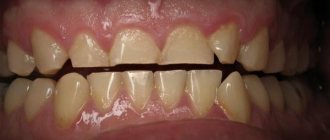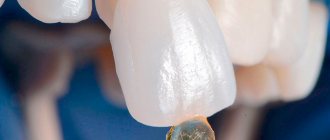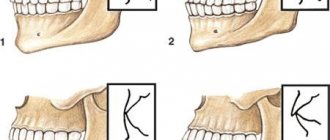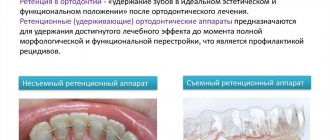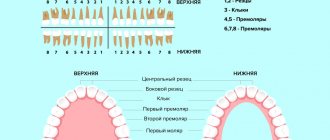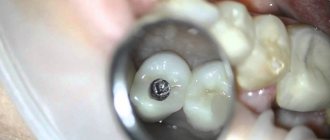Yes, unfortunately, sometimes the bite problem is not noticeable. But this does not make it smaller: due to improper closure of teeth, the enamel experiences increased stress, wears out and is gradually destroyed.
Straight teeth and malocclusion - it happens
And if at some point prosthetics are needed, it may turn out that implants cannot be installed. The fact is that during implantation, the installed pin must integrate into the bone tissue and take root, replacing the tooth root. If, when chewing, the pressure on the teeth is distributed incorrectly, and this usually happens with malocclusion, then an increased load will constantly be placed on the implant. This greatly increases the risk of rejection. In this case, an experienced implantologist simply will not undertake prosthetics and will recommend that the patient first consult an orthodontist.
To avoid this, it is better to correct the bite at a young age, when the teeth are healthy. First you need to diagnose the problem.
What is a straight bite
Direct bite refers to the closure of the dentition, in which the lower edges of the upper and lower teeth touch.
If a person has straight teeth, then such a smile seems flawless. Often such a bite appears in advertisements for toothpastes or chewing gum, which misleads viewers. In fact, direct bite is a variant of pathology, despite the above advantages. If you find your child's teeth are closing in this way, you should contact your dentist as soon as possible. Otherwise, serious complications will arise.
Bite pathologies are present in approximately 80% of the world's population. For some people, incorrect alignment of the dentition causes serious functional (difficulty in chewing, pain when opening the mouth, clicking in the temporomandibular joint) and aesthetic disorders, while for others the problem is less pronounced. In any case, an incorrect bite not only contributes to the disruption of the beauty of a smile, but also has a detrimental effect on health. Incorrect position of the teeth triggers a restructuring of the musculoskeletal system, slowly adapting muscles and ligaments to the changed “comfortable” position of the dentofacial apparatus. In addition, bite pathologies in most cases disrupt the processes of chewing food, so patients with dental anomalies often experience problems with the gastrointestinal tract.
Incorrect bite leads to a large number of problems in the oral cavity. Inflammatory periodontal diseases, the appearance of increased tooth sensitivity, abrasion, chipped restorations - all this can occur if the teeth occupy an incorrect position in the dental arch.
To correct imperfections in your smile and straighten your teeth, contact orthodontist Irina Butorina.
What kind of bite should a person have?
Occlusion is the nature of the juxtaposition of the dentition during the habitual closure of the jaws.
There are physiological and pathological types of occlusion. Physiological:
- Orthognathic is the most correct bite, in which there are close contacts between the teeth and dentition, as well as 1/3 of the crowns overlap the lower dentition with the upper one.
- Progenic – a bite in which the lower jaw is slightly pushed forward.
- Straight bite - a bite in which the teeth of the upper and lower jaws touch the cutting edges and cusps in the usual occlusion.
- Biprognathic - a bite characterized by an inclination of the crowns of the teeth towards the vestibule of the mouth.
Physiological types of occlusion are not capable of leading to disturbances in the dental system, therefore they are considered as a variant of the norm.
Pathological:
- Deep – a type of bite in which the upper teeth overlap the lower teeth by more than 1/3 of the crown;
- Crossbite – a bite in which the upper teeth overlap the lower teeth in one segment, and vice versa in the other.
- Open bite – characterized by non-occlusion of the teeth in the position of central occlusion.
- Distal – a bite characterized by a large upper jaw.
- Mesial - a bite in which the lower jaw moves forward.
Pathological types of bite can cause serious disturbances in the functioning of the masticatory apparatus, as well as spoil the aesthetics of a smile.
Is it possible to determine the type of bite yourself? In most cases, this is very difficult to do, so it is better to consult a qualified orthodontist.
Butorina Irina Aleksandrovna is an orthodontist with more than 14 years of experience. The doctor has more than 1000 grateful reviews from patients who have already entrusted the specialist with transforming their smile!
Causes of dental deformities
Dental deformations are violations of the location of teeth in the dental arch, which lead to improper distribution of chewing pressure and worsening oral health.
The main causes of dental deformation in childhood are:
- Hereditary predisposition. In some cases, if parents have an incorrect bite, it is genetically passed on to the child.
- Using the wrong pacifiers and nipples for feeding. The feeding hole of the bottle should be at the bottom so that the baby can keep his tongue in a natural position while sucking. Pacifiers should be very thin at the base so that the baby's teeth are in a closed position.
- Using pacifiers after one year/Breastfeeding after one year. Prolonged sucking can lead to the formation of an infantile type of swallowing. In this case, the tongue “gets used” to resting on the teeth and gradually pushing them out.
- Poor oral hygiene. The accumulation of large amounts of plaque in the oral cavity contributes to the formation of caries. In childhood, all carious processes develop rapidly, so they very quickly turn into complicated forms. Unfortunately, some forms of complicated caries cannot be cured conservatively, so teeth have to be removed long before the physiological change. Early removal of baby teeth can lead to crowding of permanent teeth.
- Caries of milk teeth. If the caries of a temporary tooth is not treated in time, the infection can spread to the permanent tooth. This will manifest itself as a change in the shape, shade or size of the permanent tooth.
- Mouth breathing.
- Diseases of the ENT organs.
- Bad habits (finger sucking, holding foreign objects in the mouth, biting cheeks and lips, etc.).
- Postponed rickets.
- Diseases of the nervous system.
- Mother's illnesses during pregnancy.
The main causes of dental deformation in adulthood:
- Bad habits (biting a pen, biting a thread, etc.).
- Traumatic injuries.
- Long-term absence of one or more teeth in the oral cavity.
- Increased tooth wear.
- Impaired bone density.
- Diseases of periodontal tissues.
- Eruption of wisdom teeth.
What are crooked teeth?
For most people, crooked teeth are teeth of irregular shape, size, or those that are very different in position in the dentition.
But the curvature of teeth can be different. There are three main groups of deformations: dental anomalies, dentition anomalies, and dentition relationship anomalies. The first group includes individual teeth that differ in shape, size or shade from the rest of the dentition. The second group includes deformations formed during the eruption of several teeth at once, which violate the aesthetics of the entire dentition. The third group is deformations that occurred at the level of the jaws and entail their incorrect closure. Bite pathologies can appear at any age, so the process involves both permanent and temporary teeth.
Temporary teeth Often temporary teeth erupt with some curvature, but gradually take the correct position in the jaw. This feature is associated with intensive growth and development of the jaw bones in childhood. Unfortunately, in some cases, temporary occlusion is subject to the following defects: crowding of teeth, delayed eruption, early tooth loss, open bite, etc. All this can be avoided if you consult an orthodontist in time. The first visit for the purpose of prevention can be made at the age of 2 years.
Permanent teeth The eruption of permanent teeth largely depends on the condition of the temporary occlusion. In order to correct the condition of permanent occlusion in a timely manner, it is important to consult an orthodontist for a consultation.
Do I need to correct crooked teeth?
It is necessary to correct uneven teeth for the following reasons:
- An incorrect bite creates a functional overload on certain groups of teeth, which entails their rapid destruction;
- Deformations of the dentition lead to disruption of the normal functioning of the temporomandibular joint, hypertonicity of the masticatory muscles and overload of periodontal tissues;
- Crooked teeth are more susceptible to caries than others, and they are difficult to treat due to their incorrect position in the dental arch;
- An incorrect bite can cause problems in the gastrointestinal tract and respiratory system.
Orthodontist Irina Aleksandrovna Butorina will help correct the position of the teeth. You can make an appointment with a specialist by calling 8 926 203 32 32.
Up to what age is correction possible?
Many people believe that bite correction can only be done in childhood.
This opinion is not entirely correct. Modern orthodontics allows you to correct the condition of the dentofacial apparatus at any age, so there is no longer a time period for acquiring a beautiful smile! However, it should be understood that different age groups require completely different approaches to treatment. For example, in children, orthodontic treatment is faster and easier, since the dentofacial apparatus is at the stage of formation. Adult patients require longer treatment because their jaws have finished growing.
Overview of correction methods
You can correct crooked teeth using the following methods:
- Removable/fixed orthodontic structures (braces, aligners, plates, mouth guards, trainers, etc.);
- Surgery;
- Restoration of dental defects.
But how not to make a mistake when choosing a treatment method?
The orthodontist chooses methods for correcting malocclusion individually in each case. The choice depends on the patient’s age, as well as the growth characteristics of the components of the dentofacial apparatus. For example, in childhood, the facial part of the skeleton has not yet completed its growth, so all stages of orthodontic treatment should be aimed at stimulating the correct development of the jaws. For these purposes, the orthodontist may prescribe wearing special removable or non-removable structures, as well as performing certain exercises to strengthen the muscles of the oral cavity.
The teenage period is characterized not only by hormonal changes in the body, but also by a change in bite. Jaw growth continues, so it is important to properly influence the structures of the maxillofacial apparatus. During this period, plates can be fixed to temporary teeth, and braces can be placed on permanent teeth.
Gradually, jaw growth stops. This usually happens by age 21. The condition of a permanently formed bite can be corrected with the help of braces, aligners or surgical operations (in more complex cases). Sometimes for effective treatment it is necessary to combine surgery with wearing an orthodontic appliance.
For minor tooth curvatures that do not cause functional impairment, orthodontic treatment can be avoided. In this case, it is necessary to restore the tooth using veneers, crowns or filling material.
How long does it take to straighten teeth?
Only a specialist can establish specific terms for orthodontic treatment after examining the oral cavity and carrying out diagnostic measures. On average, the duration of therapy with an orthodontist lasts from one to three years.
Prevention of crooked teeth
It is important to prevent the appearance of crooked teeth from a very early age. Parents should follow the following recommendations:
- Visit an orthodontist for preventive examinations from the age of 2-3 years at least once a year.
- Avoid pacifiers/pacifiers/breastfeeding if the child is over a year old. For up to a year, use only orthodontic pacifiers and pacifiers.
- Perform lip and tongue frenuloplasty in a timely manner on the recommendation of an orthodontist and pediatrician.
- Attend preventive dental examinations, as well as professional oral hygiene procedures at least once every six months.
- Treat caries and its complications in a timely manner.
- Eliminate bad habits (chewing a pen, biting threads, etc.).
- Gradually introduce solid foods into complementary foods.
- Learn to use a sippy cup.
- Starting from the first tooth, brush your teeth with a brush and toothpaste in the morning and evening. Hygiene products should be selected according to age.
- Rinse your mouth after every meal.
- Perform myogymnastics exercises (as recommended by the orthodontist).
- Treat diseases of the ENT organs in a timely manner.
- Follow a balanced diet, which will be dominated by fresh fruits and vegetables.
Conclusions. Expert advice
Bite defects can appear at any age for a huge number of reasons.
Currently, such imperfections can be eliminated if you consult an orthodontist in time. The specialist will draw up an individual treatment plan and restore the beauty and charm to your smile! An orthodontist in Moscow, Butorina Irina Aleksandrovna, has been correcting malocclusion for more than 14 years. The specialist has a large number of positive reviews from patients who have already entrusted their health to her!
You can make an appointment for a consultation with Irina Alexandrovna by calling 8, 8 926 203 32 32.
The specialist conducts consultations at the address: metro Botanical Garden, Lazorevy proezd 3, DentalArt Clinic
Is a straight bite normal?
If we are talking about a physiological bite, then in this case the upper row of teeth slightly covers the lower one. This does not happen with a straight bite.
Such occlusion cannot be considered normal, since it is fraught with the appearance of a number of defects and disorders, despite a visually ideal smile (if the person has straight teeth).
Important: straight bite is bad . Here are some problems that people with a straight bite experience:
- With a direct bite, the lower jaw gradually moves forward, which is why the bite becomes progenic.
- The enamel wears off at an accelerated rate due to heavy loads on the teeth.
- The jaw also experiences heavy loads, which is fraught with pain and problems in the functioning of the temporomandibular temple.
- Increased risk of developing caries and periodontal disease.
Types of malocclusion
In practice, there are several types of anomalies. The bite happens:
- distal (when the jaw protrudes forward from above, and the lower jaw is underdeveloped);
- mesial (teeth move forward from below);
- open (some teeth in a row do not close together);
- deep (the jaw on top “sits” on the lower jaw by more than half);
- cross (displacement of rows in the horizontal plane);
- dystopia (molars are positioned incorrectly).
Features of direct bite
The main feature of a direct bite is the parallel closure of the jaws, in which the upper incisors do not overlap the lower ones. Other features of a straight bite include:
- increased load on the front teeth;
- violation of the proportions of the lower part of the face (occurs over time if the bite is not corrected);
- clicks when opening and closing the mouth associated with dysfunction of the temporomandibular joint;
- pain in the cervical region and headaches arising from problems with the jaw joints.
Prices
| Name of service | price, rub. |
| Preliminary orthodontic analysis: taking an impression from one row of teeth, making a working model, orthopantomogram analysis, photographic examination | from 4000 |
| Correction of malocclusions and tooth position using a simple plate | from 19600 |
| Fixed appliance (braces) for correcting the position of the front teeth | from 40000 |
| Standardized positioners (Myobrace, LM-activator) | from 14000 |
| Vestibular plates (Dr. Hinz Dental) | from 7000 |
| Repeated (control) visits during treatment with removable devices | from 890 |
| Repeated (control) visits during treatment with fixed devices | from 1740 |
| Repairing a removable device | from 2620 |
Causes of direct bite
The main reasons for direct closure of the dentition include:
- Heredity . The position of the jaws and the placement of teeth in a straight bite are often determined by hereditary factors. This type of pathology is more difficult to correct than others.
- Disorders of intrauterine development . Much depends on the condition of the pregnant woman. Bad habits, hypovitaminosis, stress and other unfavorable factors negatively affect the health of the fetus, including the condition of the dental system.
- Artificial feeding and pacifiers . Often, a child develops malocclusion when using pacifiers for a long time.
- Bad habits in a child . Habits such as thumb sucking and other objects negatively affect bite formation. It is important to wean your child off this as early as possible.
Existing bite pathologies
A protruding upper or lower jaw arch, lack of contact between the cutting edges - these and other signs indicate anomalies in the development of the bite. As noted above, there are five types of pathologies in orthodontics:
- distal
- the top row hangs strongly over the bottom, - mesial
- excessively protruding lower jaw, - deep
- the bottom row is covered by more than 50%, - open
- lack of contact and the appearance of a gap between the rows, - cross
- a developmental disorder of the jaw system, as a result of which the dental arches unevenly cover each other in front or on the sides.
Anomalies include dystopia, when one or more teeth are in the wrong place or position, and diastema, an excessively increased interdental distance. These abnormal phenomena are often the culprits of a malocclusion. Dystopia often contributes to the formation of an open bite.
Diagnosis of direct bite
Typically, an orthodontist can make a diagnosis based on an external examination alone. However, to clarify the diagnosis and select a treatment method, the patient undergoes additional instrumental studies:
- Occlusiogram - determination of areas of contact between the edges of the teeth. It is performed using special wax plates.
- X-ray of the facial part of the head . Performed in frontal and lateral projection.
- Panoramic radiography (orthopantomography).
- Electromyography is a study of the muscular system.
Treatment of direct bite
Straight bite is a problem that can be successfully treated. Modern dentistry has a solid arsenal of techniques for correcting all types of non-physiological bites, including direct bites. Today, treatment of direct bite in adults and children is carried out using special orthodontic structures:
- Braces . This is the main method of correction, allowing you to achieve the desired result relatively quickly. Treatment with braces is recommended to begin in adolescence, when the dental system is not yet fully formed. The type of braces, as well as the duration of wearing them, is selected by the doctor.
- Mouth guards and retainers. Retainers are worn after braces. These designs allow you to consolidate the results achieved with braces. However, both mouthguards and retainers help avoid the severe consequences of a direct bite. In particular, this is excessive wear of teeth.
Methods of therapy for correcting bite
Correcting a bite most often means exclusively wearing braces. Indeed, they are often used (and not only for children), but other methods are also used in orthodontics. They can be divided into two groups - surgical and non-surgical.
Surgical methods
Surgical intervention is necessary in three cases:
- when there is high crowding, when it is necessary to remove quarter premolars to make room for other teeth;
- with serious jaw abnormalities;
- to speed up treatment.
Severe pathologies of the jaw bones, which lead to malocclusion and disturbances in swallowing and breathing, cannot be corrected without surgery. During the operation, the surgeon cuts the bone tissue in the places where the teeth need to be moved. At this time, the patient is under general anesthesia in the inpatient department. Rehabilitation after surgery takes up to three weeks. After the tissues are restored, the jaw will have to be developed. Most often, additional treatment is required: the doctor prescribes braces, which must be worn for at least six months. The type of braces, duration of wearing them, and location depend on the current state of the bite.
Surgery can also be used to shorten the treatment time for malocclusion. Orthodontists use what is called a corticotomy, a small operation performed after braces are installed.
About a week after installation, the patient comes to the periodontist, who uses a piezotome to make small incisions in the gums. The entire operation takes about 30 minutes and is performed under local anesthesia. Occasionally, sedatives are also used - general anesthesia is usually not needed.
After corticotomy, the patient will have to visit the orthodontist and periodontist several more times to remove sutures, monitor the condition of the gums and correct the braces. The operation significantly speeds up treatment – by 3–6 months.
Important: surgical intervention is prescribed only in adulthood, after the jaw is fully formed (usually after 16 years). There are a number of standard contraindications: HIV, cancer, heart disease, etc.
Treatment without surgery
If we are not talking about serious pathologies of the jaw, orthodontists and their patients do without surgical treatment methods. Correction of the bite occurs through the installation and long-term wearing of braces, mouthguards and other devices.
Braces are the most effective way to eliminate pathology. They are a power arch with brackets that are secured to the teeth. The arch provides constant pressure on the teeth, and they gradually move, taking the right place.
Braces are worn without interruption. They are removed only at an appointment with the orthodontist, during correction. Over the entire period of treatment (which ranges from 6 months to 3 years), several visits to the doctor may be required. The procedure and duration of treatment depend on the condition of the teeth and the chosen braces system. Thus, self-ligating ones do not require too frequent visits to the orthodontist.
In addition to braces, there are other methods of therapy. Thus, mouthguards are often used - removable devices made of transparent material, and if we are talking about three, microprosthetics (veneers) are chosen.
Consequences
The main danger of a direct bite is accelerated wear of teeth. This happens despite the fact that enamel is considered one of the strongest biological materials. With constant contact between the cutting surfaces of the teeth, hard tissues are quickly destroyed, unable to withstand the load.
Let's look at the typical consequences of a straight bite:
- Toothache . With the destruction of hard tissues, teeth begin to hurt over time. It is advisable not to let it get to this point, but to consult a doctor as soon as a defect is discovered.
- Tooth decay . Sometimes people with a straight bite refuse to acknowledge the problem until their teeth are completely destroyed. In this case, the only way to help is with prosthetics.
- Aesthetic problems . Initially, a straight bite really looks beautiful. However, as teeth wear down, the smile deteriorates. The length of teeth can be reduced by 35-40%, which leads to aesthetic defects.
- Caries . Destruction of hard tooth tissues significantly increases the risk of developing caries. In turn, caries only accelerates the process of destruction due to the action of organic acids secreted by bacteria.
- Periodontal disease . The addition of an infection is fraught with the development of gum disease. Against the background of tooth wear and caries, periodontal disease often develops.
- Disorders of the temporomandibular joint . This leads to characteristic clicking sounds when opening and closing the mouth. Later, when working with the jaws, pain occurs. In addition, dysfunction of the temporomandibular joint leads to deterioration of hearing and diction.
Important . It is difficult to predict the above complications. In this regard, doctors strongly recommend correcting malocclusion as soon as possible.
Diagnostic stage
Several methods are used in the diagnosis of pathological occlusion:
- clinical.
The doctor analyzes the medical history, conducts a visual examination of the patient, performs an instrumental analysis of the patient’s mouth and nasopharynx, checks the functioning of the muscles and ligaments of the jaws; - functional.
Allows you to determine the degree of tooth displacement and the cause of the disease. Functional diagnostics is also aimed at identifying disturbances in the functioning of the TMJ, skeletal asymmetry, occlusion discrepancies, assessing the process of breathing, swallowing, chewing, and human speech; - X-ray.
Side and frontal projection images are studied. If necessary, a person undergoes a computed tomography (CT) scan, which reflects the condition of the tooth roots and jawbone.
Prevention
We can talk about preventive measures regarding direct bite if the child does not have a genetic predisposition to this anomaly. You can reduce the likelihood of developing an abnormal bite by adhering to the following recommendations:
- Adequate nutrition for a woman during pregnancy . It is important that a woman consumes enough calcium. This element is found in broccoli, dairy products, and sesame. A sufficient amount of calcium is important for the health of your baby's bones and teeth.
- Natural feeding. Keep your baby breastfed for as long as possible.
- No bad habits. These include thumb sucking or an obsession with pacifiers and bottles with pacifiers. Often against this background, children develop mouth breathing, which changes their bite.
- Balanced nutrition for a child . The child’s menu should have enough protein, vitamins and minerals. Try to minimize the consumption of simple carbohydrates (sugar, sweets, flour).
- Regular examinations with a doctor . Take your child to see a doctor twice a year.
How to identify malocclusions?
Only a qualified specialist can make an accurate conclusion about whether there were disturbances in the formation of the bite. For this purpose, the orthodontist prescribes radiography of the dental system. However, a number of factors can indicate existing problems and help take appropriate measures aimed at the timely identification and elimination of defects in the development of occlusion. You should be concerned if you notice one or more of the following signs:
- permanent appearance of heavy plaque in the same areas,
- bleeding of gum tissue,
- pronounced displacement of the jaw arch,
- Difficulty pronouncing sibilants.
Plaque formed in the same areas indicates that these areas are not involved in chewing food, which may indicate a malocclusion. You should also pay attention to the condition of your dental arches even if there are significant distances between the teeth, uneven placement of teeth, crowded arrangement, etc.
Characteristics of normal physiological occlusion:
- the central distance between the incisors on both jaws is the same,
- the upper cone-shaped teeth (fangs) cover the lower ones by no more than 1/3,
- chew food equally comfortably on the left and right,
- symmetrical lower part of the facial oval.
To determine the absence of pathologies, you can close your jaw and open your lips in front of a mirror - if the teeth are completely in contact and the top row is slightly pushed forward, then the bite is normal.
Treatment of direct bite at the CIS clinic
At the Israeli Dentistry Center, straight bites are treated by experienced orthodontists. Our clinics on the Left Bank (Kyiv) are equipped with modern diagnostic equipment that allows us to establish an accurate diagnosis. Based on the data obtained, we select individual treatment for each patient.
Treatment with braces for direct bite: before and after
Preventive measures
The risk of developing an anomaly in a child can be reduced to a minimum by the following measures:
- See your doctor regularly during pregnancy.
- Eat nutritiously during pregnancy (particular attention should be paid to foods containing large amounts of calcium).
- Breastfeed your baby.
- Control the baby's breathing (it should be nasal).
- Wean off the pacifier in a timely manner. Its period of use should be limited to three years.
- Take your child to the dentist regularly.
What is the period of mixed dentition, and what parents need to pay attention to.
In this article we will tell you all the most important things about senile progeny.
Follow the link https://orto-info.ru/zubocheliustnye-anomalii/okklyuzii/profilaktiki.html to learn more about the kit for the prevention of malocclusions.
FAQ
Is it possible to correct a straight bite on your own?
On the Internet you can find various massage techniques and exercises that supposedly will help correct your bite. Such methods are not only ineffective, but also harmful. Under no circumstances should you resort to self-medication, especially when you do not know the exact diagnosis. To identify the problem and solve it, be sure to consult a doctor.
Is it possible to live with an incorrect bite?
It's possible, but not necessary. Above we have provided a list of complications and adverse consequences of direct bite. Any other malocclusion is also fraught with the development of complications. Correct bite is the key to healthy not only teeth, but also other organs and systems.
How does your bite affect your appearance?
It all depends on what kind of bite we are talking about. For example, a shortened upper jaw or a massive lower jaw makes the face angry and disproportionate.
How much does straight bite treatment cost?
The price depends on the volume and complexity of the treatment. As a rule, the cost of treatment is discussed in detail after diagnosis, when doctors understand the patient’s treatment strategy.
Benefits of Invisalign trays
- Efficiency. If you can correct your malocclusion with braces, Invisalign clear overlays will be just as effective, and often more effective.
- Convenience and easy care. The aligners can be removed while eating and brushing your teeth.
- Stealth. The aligners are made of durable and transparent plastic. They are invisible in conversation and in photographs.
- Comfort. When worn, the aligners do not create a feeling of discomfort in the mouth, do not rub the gums, and do not change the patient’s diction. It will take you a maximum of 2 hours to get used to them.
- Safety. Gums and tooth enamel are not damaged during treatment.
PROPRICUS dental specialists who will help you forget about dental malocclusion forever
Pokrovskaya Natalya Sergeevna
Head of the Department of Orthodontics
He specializes in solving problems with malocclusion using Invisalign aligners, and is involved in neuromuscular diagnostics and pediatric orthodontics. Work experience - 10 years.
